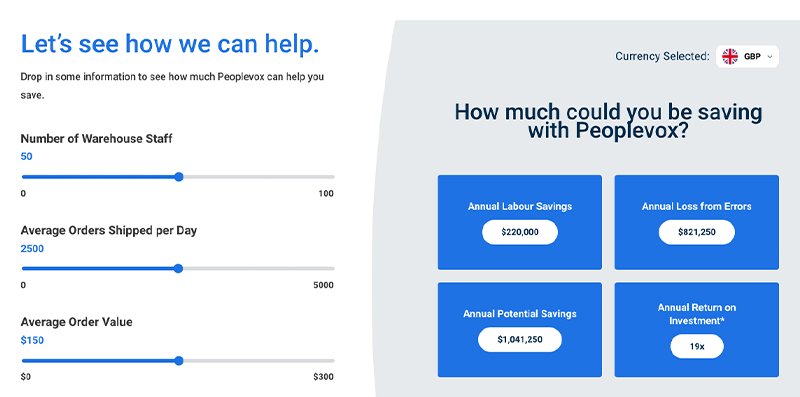How much does a warehouse management system (WMS) cost?
Descartes Peoplevox Pricing Breakdown
One-Time Cost
Implementation
One-Time Cost
from – $11,600
- Project management, recorded training sessions
- Best practice consultancy, system setup and ongoing configuration
- Integrations and User Acceptance Testing
- Dedicated Go-Live support
On-Going Costs
Platform
Monthly Cost
from $2,050 p/m
- Pre-sales consultancy and tech stack design
- All core components: receiving, pick, pack, dispatch, inventory and reporting
- 5 concurrent users
- Designated Client Success and 24/7 support
Users
Monthly Cost
from $234 p/m
- Up-front committed users for lifetime of contract
- Based on concurrent usage rather than total log-ins
- Add ‘flex-up’ users for minimum one-month terms
- Add fixed users through Client Success when required
Add-Ons
Monthly Cost
from $255 p/m
- Can be included in initial contract or added at a later date, when necessary
- Configurable dashboards
- Pick and sort to trolley
- Mobile dispatch
- Returns
Achieve Remarkable ROI with a WMS
Streamlining operations and automating tasks
Real-time inventory tracking
Productivity reporting and dashboards
“Peoplevox helped us instantly improve picking accuracy and efficiency.”
We’ve streamlined our warehouse operations, improved order accuracy, and reduced labour costs. The real-time data insights provided by Descartes Peoplevox empowered us to make data-driven decisions, ultimately boosting our bottom line.

Rob Hollis
Continuous Improvement Manager, The AYBL Group
99.9%
Shipping accuracy
30%
Faster Shipping
35%
Reduction in Costs
80%
Increased inventory accuracy
ROI Calculator
Learn how much Descartes Peoplevox can help you save.
Ecommerce WMS Benefits
Enhanced Operational Efficiency
Improved Accuracy and Inventory Control
Scalability and Growth Support
What’s Included with Descartes Peoplevox?
Set up and Platform
Mobile Barcode Scanning
Offline Mode
Barcode Capture
Configurable Workflows
Inventory Management
Warehouse Management
Adjust Inventory
Quick Register
Inventory Count
Scan to Move
Scan to Remove
Pick, Pack and Dispatch
Failed Pick Management
View and handle failed actions on the web application. Check stock in location and adjust accordingly.
Failed Pick Re-Routing
Pick by Order
Unpick Items
Pick for Stores
Reports and Dashboards
Configurable Reports
Audit Trail
Configurable Dashboards
Order Event Tracking
Talk to Us
Talk to us about your ambitions and current challenges. Our experienced team will be able to see what’s possible.
Streamlining operations and automating tasks
Real-time inventory tracking
Productivity reporting and dashboards


